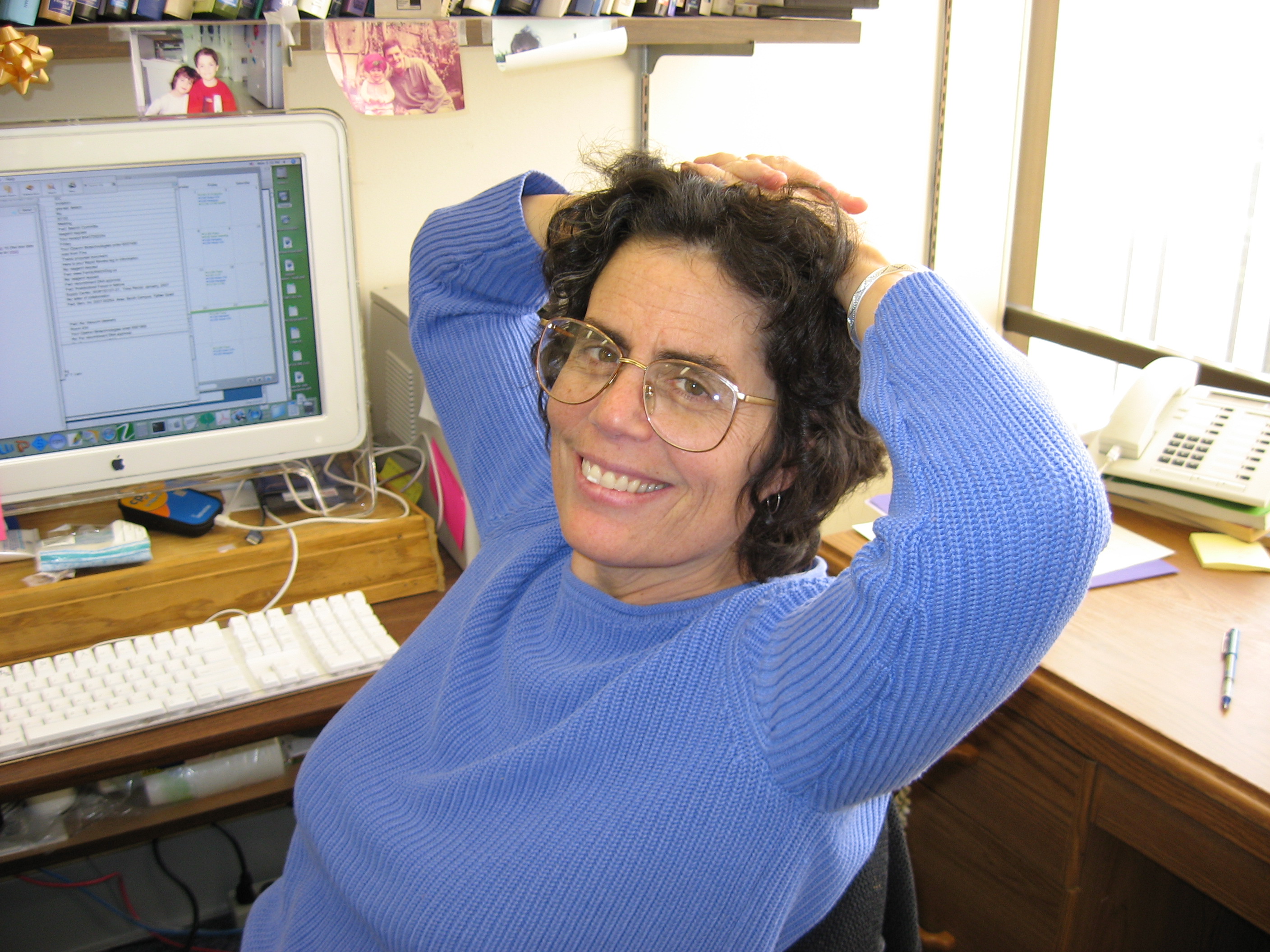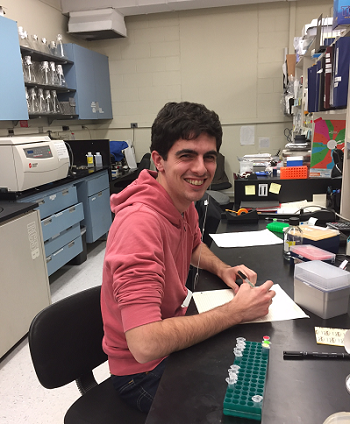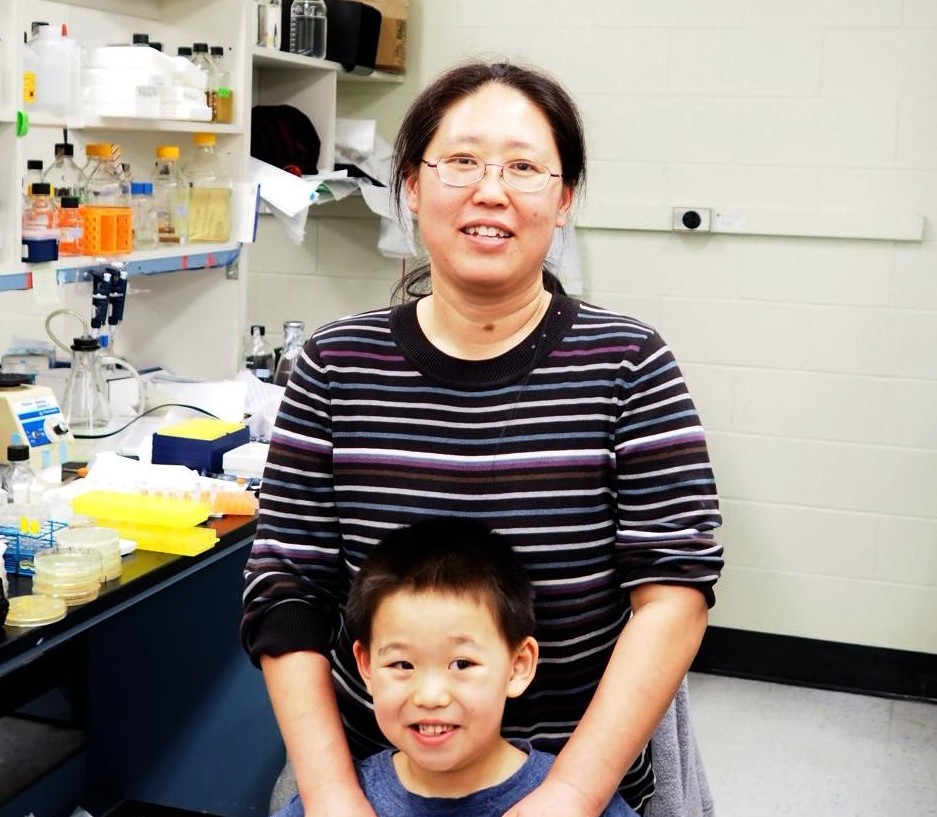Nancy Marie Hollingsworth, Ph.D.
 Distinguished Teaching Professor
Distinguished Teaching Professor
Department of Biochemistry and Cell Biology
314 Life Sciences Building
Stony Brook University
Stony Brook, NY 11794-5215
Office telephone: 631-632-8581
Lab telephone: 631-632-8583
Fax: 631-632-8575
E-mail: Nancy.Hollingsworth@stonybrook.edu
- Research Description
Meiosis is a specialized type of cell division used by sexually reproducing organisms to produce haploid gametes from diploid cells. Errors in meiosis in humans result in chromosomal imbalances that result in infertility and birth defects such as Down and Turner syndromes. Meiosis is highly conserved through evolution. The budding yeast, Saccharomyces cerevisiae, has been an excellent model organism in which to study meiosis due to its sophisticated genetics and ease of biochemical, molecular and cytological analyses. Many genes known to cause sterility in mammals were first identified in yeast.
My lab uses a variety of approaches to understand chromosome behavior during yeast meiosis. We are particularly interested in the role that phosphorylation plays in meiotic chromosome segregation. A major difference between meiosis and mitosis is the reduction in chromosome number accomplished by having two rounds of chromosome segregation follow a single round of chromosome duplication. Proper segregation of homologs at Meiosis I requires that the chromosomes be physically connected by a combination of reciprocal crossovers and sister chromatid cohesion. To generate crossovers, programmed double strand breaks (DSBs) are made and repaired preferentially using homologs, as opposed to sister chromatids (interhomolog bias). Recombination is regulated at several different levels by phosphorylation. My lab has focused on two kinases, Mek1, a meiosis-specific kinase required for interhomolog bias and the meiotic recombination checkpoint, and Cdc7-Dbf4, a highly conserved cell cycle kinase that is necessary for DSB formation, cohesin removal, mono-orientation of sister kinetochores at Meiosis I and meiotic progression. To generate unbiased lists of substrates for these two kinases at different stages of meiosis, we have developed a method for doing Stable Isotope Labeling in Cell Culture (SILAC) in sporulating cells. After pre-growing cells in synthetic medium containing either normal or heavy versions of arginine and lysine, the cells are induced to arrest in meiotic prophase, and an analog-sensitive version of either Mek1 or Cdc7 is inhibited in the heavy culture. This allows phosphatases to remove Mek1 or Cdc7-dependent phosphates, which then cannot be replaced due to inactivation of the kinase. The heavy and light cultures are then combined, crude chromatin is isolated and digested with trypsin, and phosphopeptides enriched using immobilized metal affinity chromatography (IMAC). The identity and location of the phosphosites are determined by mass spectrometry. Potential Mek1 or Cdc7-dependent phosphosites are indicated by phosphopeptides that are more abundant in the light culture compared to the heavy.
Now that we have a list of phosphopeptides at different points in meiotic prophase, we are in the process of mutating phosphosites to determine the functional significance of the phosphorylation. In this way, we have found the phosphorylation of the C terminus of the synaptonemal complex protein, Zip1, is essential for regulating the formation of crossovers, as opposed to non-crossovers. Further studies of other phosphorylated proteins should lead to a greater understanding of how meiotic chromosome behavior is regulated.
- Publications
Weng, Q, L. Wan, G.C. Straker, T. D. Deegan, B. P. Duncker, A. M. Neiman, E. Luk and N. M. Hollingsworth (2024) An acidic loop in the FHA domain of the yeast meiosis-specific kinase Mek1 interacts with a specific motif in a subset of Mek1 substrates Genetics 228: https://doi.org/10.1093/genetics/iyae106.
Nunez, G., K. Zhang, K. Mogbheli, N. M. Hollingsworth and A. M. Neiman (2023). Recruitment of the lipid kinase Mss4 to the meiotic spindle pole promotes prospore membrane formation in Saccharomyces cerevisiae. Mol. Biol. Cell doi: 10.1091/mbc.E22-11-0515.
Ziesel, A., Q. Weng, J.S. Ahuja, A. Bhattacharya, R. Dutta, E. Cheng, G.V. Börner, M. Lichten and N. M. Hollingsworth (2022) Rad51-mediated interhomolog recombination during budding yeast meiosis is promoted by the meiotic recombination checkpoint and the conserved Pif1 helicase. PLoS Genetics 18:e1010407 doi: 10.1371/journal.pgen1010407
Hollingsworth, N. M. A new role for the synaptonemal complex in the regulation of meiotic recombination. Genes Dev. 2020 34: 1562-1564 doi: 10.1101/gad.345488.120
He, W., H.B.D.P. Rao, S. Tang, N. Bhagwat, D. S. Kulkarni, M.A.W. Chang, C. Hall, L. Singh, X. Chen, N. M. Hollingsworth, P. Cejka, and N. Hunter. (2020) The crossover function of MutSg is activated via Cdc7-dependent stabilization of Msh4. Mol. Cell 78:(1): 168-183.e5.doi: 10.1016/j.molcel.2020.02.001.
Sandhu, R., Neria, F. M. Neria, J. M. Neria, X. Chen, N. M. Hollingsworth, and G. V. Börner (2020) DNA helicase Mph1 FANCM ensures meiotic recombination between parental chromosomes by dissociating precocious displacement loops. Dev. Cell 53:458-472 doi: 10.1015/j.devcel2020.04010
Hollingsworth, N. M. and R. Gaglione (2019) The meiotic-specific Mek1 kinase in budding yeast regulates interhomolog recombination and coordinates meiotic progression with double strand break repair. Current Genetics https://doi.org/10.1007/s00294-019-00937-3.
Hollingsworth, N. M. and R. Gaglione (2019) The meiotic-specific Mek1 kinase in budding yeast regulates interhomolog recombination and coordinates meiotic progression with double strand break repair. Current Genetics https://doi.org/10.1007/s00294-019-00937-3.
Chen, X.*, R. Gaglione*, T. Leong, L. Bednor, T. de lost Santos, E. Luk, M. Airola and N. M. Hollingsworth (2018) Mek1 coordinates meiotic progression with DNA break repair by directly phosphorylating and inhibiting the yeast pachytene exit regulator Ndt80. PLoS Genetics, 14(11):e1007832. doi: 10.1371/journal.pgen.1007832. *co-first authors
Subramanian, V. V., X. Zhu, T. E. Markowitz, L. A. Vale-Silva, P. A. San-Segundo, N. M. Hollingsworth, S. Keeney and A. Hochwagen (2019) Persistent DNA-break potential near telomeres increases initiation of meiotic recombination on short chromosomes. Nat Commun. 2019 Feb 27;10(1):970. doi: 10.1038/s41467-019-08875-x.
Kniewel, R., H. Murakami, Y. Liu, M. Ito, K. Ohta, N. M. Hollingsworth and S. Keeney (2017) Histone H3 threonine 11 phosphorylation is catalyzed directly by the meiosis-specific kinase Mek1 and provides a molecular readout of Mek1 activity in vivo. Genetics doi: 10.1534/genetics. 117.300359.
Prugar, E*., C. Burnett*, X. Chen and Nancy M. Hollingsworth (2017) Coordination of double strand break repair and meiotic progression in yeast by a Mek1-Ndt80 negative feedback loop. Genetics doi: 10.1534/genetics.117.199703
*co-first authors
Chosen as a high lighted paper in Genetics and was featured in a blog on the Saccharomyces Genome Database website: http://www.yeastgenome.org/meiotic-fail-safes
Callender, T. L., R. Laureau, L. Wan, X. Chen, R. Sandhu, Saif Laljee, S. Zhou, R. T. Suhandynata, E. Prugar, W. A. Gaines, Y. Kwon, G. V. Börner, A. Nicolas, A. M. Neiman and N. M. Hollingsworth. Mek1 down regulates Rad51 activity during yeast meiosis by phosphorylation of Hed1. PLoS Genet 12(8): e1006226. doi:10.1371/journal.pgen.1006226. [ pdf reprint]
Sunhandynata RT, L Wan , H Zhou and NM Hollingsworth (2016). Identification of putative Mek1 substrates during meiosis in Saccharomyces cerevisiae using quantitative phosphoproteomics. PLoS ONE 11(5): e0155931. doi:10.1371/journal.pone. 0155931Chen, X., R. T. Suhandynata, R. Sandhu, B. Rockmill, N. Mohibullah, H. Niu, J. Liang, H-C Lo, D. E. Miller, H. Zhou, G. V. Börner and N. M. Hollingsworth (2015) Phosphorylation of the synaptonemal complex protein Zip1 regulates the crossover/noncrossover decision during yeast meiosis. PLoS Biology 13(12): e1002329. doi:10.1371/journal.pbio. 1002329. [ pdf reprint]
Suhandynata, R., J. Liang, C. P. Albuquerque, H. Zhou and N. M. Hollingsworth (2014) A method for sporulating budding yeast cells that allows for unbiased identification of kinase substrates using stable isotope labeling by amino acids in cell culture. G3 4:2125-2135.
Liu, Y. W. A. Gaines, T. Callender, V. Busygina, A. Oke, P. Sung, J. C. Fung and N. M. Hollingsworth (2014) Down-regulation of Rad51 activity during meiosis in yeast prevents competition with Dmc1 for repair of double strand breaks. PLoS Genetics 10(1): e1004005. doi:10.1371/journal.pgen.1004005Callender, Tracy L. and N. M. Hollingsworth (2010) Mek1 suppression of meiotic double strand break repair is specific to sister chromatids, chromosome autonomous and independent of Rec8 cohesin complexes Genetics 185:771-782. [ pdf reprint]
Hollingsworth, N. M. Phosphorylation and the creation of interhomolog bias during meiosis in yeast (2010) Cell Cycle 9: 1-2. [ pdf reprint]
Mok, J. A. Mok, P. M. Kim, H. Y. K. Lam, S. Piccirillo, X. Zhou, G. R. Jeschke, D. L. Sheridan, S. A. Parker, V. Desai, M. Jwa, E. Cameroni, H. Niu, M. Good, A. Remenyi, J-L. N. Ma, Y-J-Sheu, H. E. Sassi, R. Sopko, C. C. Chan, C. De Virgilio. N. Hollingsworth, W. A. Lim, D. F. Stern, B. Stillman, B. J. Andrews, M. B. Gerstein, M. P. Synder, and B. E. Turk (2010) Breaking the protein kinase code through large-scale analysis of yeast phosphorylation motifs. Science Signaling 3:ra12.
Niu, H., L. Wan, V. Busygina, Y. Kwon, J. A. Allen, X. Li, R. C. Kunz, K. Kubota, B. Wang, P. Sung, K. M. Shokat, S. P. Gygi and N. M. Hollingsworth (2009) Regulation of meiotic recombination via Mek1-mediated Rad54 phosphorylation. Mol. Cell 36: 393-404. [ pdf reprint]
Lo, H-C., L. Wan, A. Rosebrock, B. Futcher and N. M. Hollingsworth (2008) Cdc7-Dbf4 regulates NDT80 transcription as well as reductional segregation during budding yeast meiosis. Mol. Biol. Cell. (in press). [ pdf reprint]
Hollingsworth, N. M. (2008) Deconstructing meiosis one kinase at a time: polo pushes through pachytene. Genes. Dev. 22: 2596-2600. [ pdf reprint]
Wan, L., H. Niu, B. Futcher, C. Zhang, K. M. Shokat, S. J. Boulton and N. M. Hollingsworth (2008) Cdc28-Clb5 (CDK-S) and Cdc7-Dbf4 (DDK) collaborate to initiate meiotic recombination in yeast. Genes Dev. 22: 386-397. [ pdf reprint]
Niu, H., X. Li, E. Job, C. Park, D. Moazed, S. P. Gygi and N. M. Hollingsworth (2007) Mek1 kinase is regulated to suppress double-strand break repair between sister chromatids during budding yeast meiosis. Mol. Cell. Biol. 27: 5456-5467. [ pdf reprint]
Wan, L., C. Zhang, K. M. Shokat and N. M. Hollingsworth (2006) Chemical inactivation of Cdc7 kinase in budding yeast results in a reversible arrest that allows efficient cell synchronization prior to meiotic recombination. Genetics 174: 1767-1774. [ pdf reprint]
Niu, H., B. Baumgartner, D. Schaefer, L. Wan, J. Loidl, and N. M. Hollingsworth (2005) Partner choice during meiosis is regulated by Hop1-promoted dimerization of Mek1. Mol. Biol. Cell 16: 5804-5818. [ pdf reprint]
Ira, G., A. Pellicioli, A. Balijja, X. Wang, S. Fiorani, W. Carotenuto, G. Liberi, D. Bressan, L. Wan, N. M. Hollingsworth, J. E. Haber and M. Foiani. (2004) CDK1 requirement in DNA end resection, homologous recombination and DNA damage checkpoint activation. Nature 431: 1011-1017. [ pdf reprint]
Turney, D., de los Santos, T., and N. M. Hollingsworth. (2004) Does chromosome size affect map distance and interference in budding yeast? Genetics 168: 2424.
Hollingsworth, N. M. and S. J. Brill. (2004) The Mus81 solution to resolution: Generating meiotic crossovers without Holliday junctions. Genes Dev. 18: 117-125.
Wan, L., T. de los Santos, C. Zhang, K. Shokat, N. M. Hollingsworth (2004) Mek1 kinase activity functions downstream of RED1 in the regulation of meiotic DSB repair in budding yeast. Mol. Biol. Cell 15: 11-23.
Hollingsworth, N. M. (2004). Homologous Recombination in Meiosis. In "Encyclopedia of Biological Chemistry" (William J. Lennarz and M. Daniel Lane, eds.) Elsevier, San Diego 2: 393-397.
de los Santos, T., N. Hunter, C. Lee, B. Larkin, J. Loidl, and N. M. Hollingsworth (2003). The Mus81/Mms4 endonuclease acts independently of double Holliday junction resolution to promote a distinct subset of crossovers during meiosis in budding yeast. Genetics 164: 81-94.
de los Santos, T., J. Loidl and N. M. Hollingsworth (2001) MMS4 is required for a late step of meiotic recombination in Saccharomyces cerevisiae. Genetics 159: 1511-1525.
Woltering, D., B. Baumgartner, S. Bagchi, B. Larkin, J. Loidl, T. de los Santos and N. M. Hollingsworth (2000) Meiotic segregation, synapsis and recombination checkpoint functions require physical interaction between the chromosomal proteins Red1p and Hop1p. Mol. Cell. Biol. 20: 6646-6658.
Suzuki, T., H. Park, N. M. Hollingsworth, R. Sternglanz, and W. J. Lennarz (2000). PNG1, a yeast gene encoding a highly conserved peptide:N-glycanase. J. Cell Biol. 149:1039-1051.
de los Santos, T. and N. M. Hollingsworth (1999) Red1p: A MEK1-dependent phosphoprotein that physically interacts with Hop1p during meiosis in yeast. J. Biol. Chem. 274:1783-1790.
Kironmai, K. Mary, K. Muniyappa, D. B. Friedman, N. M. Hollingsworth and B. Byers (1998) DNA-binding properties of Hop1 protein, a synaptonemal complex component from Saccharomyces cerevisiae. Mol. Cell. Biol. 18: 1424-1435.
Pochart, P., D. Woltering and N. M. Hollingsworth (1997) Conserved properties between functionally distinct MutS homologs in yeast. J. Biol. Chem. 272: 30345-30349.
Hollingsworth, N. M. and L. Ponte (1997) Genetic interactions between HOP1, RED1 and MEK1 suggest that MEK1 regulates assembly of axial element components during meiosis in the yeast, Saccharomyces cerevisiae. Genetics 147: 33-42.
Hollingsworth, N. M., L. Ponte and C. Halsey (1995) MSH5, a novel MutS homolog, facilitates meiotic reciprocal recombination between homologs in Saccharomyces cerevisiae, but not mismatch repair. Genes Dev. 9: 1728-1739.
Byers, B. and N. M. Hollingsworth (1994) DNA branching during meiotic recombination. Current Biology 4: 448-451.
Friedman, D. B., N. M. Hollingsworth and B. Byers (1994) Insertional mutations in the yeast HOP1 gene: Evidence for multimeric assembly in meiosis. Genetics 136: 449-464.
Hollingsworth, N. M. and A. D. Johnson (1993) A conditional allele of the yeast HOP1 gene is suppressed by overexpression of two other meiosis-specific genes: RED1 and REC104. Genetics 133: 785-797.
Vershon, A. K., N. M. Hollingsworth and A. D. Johnson (1992) Meiotic induction of the yeast HOP1 gene is controlled by positive and negative regulatory elements. Mol. Cell. Biol. 12: 3706-3714.
Hollingsworth, N. M., and L. Goetsch and B. Byers (1990) The HOP1 gene encodes a meiosis-specific component of yeast chromosomes. Cell 61: 73-84.
Hollingsworth, N. M. and B. Byers (1989) HOP1: a yeast meiotic pairing gene. Genetics 121: 445-462.
Dawson , P. S. and N. M. Hollingsworth (1982) Sex linkage of the glucose-6-phosphate dehydrogenase locus in the flour beetle Tribolium castaneum. Can. J. Genet. Cytol. 24: 267-271.
- Lab Personnel





